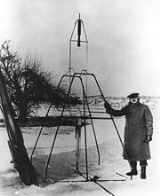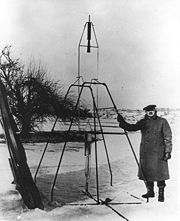
Pendulum Rocket Fallacy
Encyclopedia

Rocket
A rocket is a missile, spacecraft, aircraft or other vehicle which obtains thrust from a rocket engine. In all rockets, the exhaust is formed entirely from propellants carried within the rocket before use. Rocket engines work by action and reaction...
flight and how rockets remain on a stable trajectory
Trajectory
A trajectory is the path that a moving object follows through space as a function of time. The object might be a projectile or a satellite, for example. It thus includes the meaning of orbit—the path of a planet, an asteroid or a comet as it travels around a central mass...
. The first liquid-fuel rocket, constructed by Robert Goddard
Robert H. Goddard
Robert Hutchings Goddard was an American professor, physicist and inventor who is credited with creating and building the world's first liquid-fueled rocket, which he successfully launched on March 16, 1926...
in 1926, differed significantly from modern rockets in that the rocket engine
Rocket engine
A rocket engine, or simply "rocket", is a jet engineRocket Propulsion Elements; 7th edition- chapter 1 that uses only propellant mass for forming its high speed propulsive jet. Rocket engines are reaction engines and obtain thrust in accordance with Newton's third law...
was at the top and the fuel tank at the bottom of the rocket. It was believed that, in flight, the rocket would "hang" from the engine like a pendulum
Pendulum
A pendulum is a weight suspended from a pivot so that it can swing freely. When a pendulum is displaced from its resting equilibrium position, it is subject to a restoring force due to gravity that will accelerate it back toward the equilibrium position...
from a pivot, and the weight of the fuel tank would be all that was needed to keep the rocket flying straight up. This belief is incorrect—such a rocket will turn and crash into the ground soon after launch, and this is what happened to Goddard's rocket. Use of basic Newtonian mechanics shows that Goddard's rocket is just as unstable as when the engine is mounted below the fuel tank, as in most modern rockets.
Practical explanation
No rocket can be constructed perfectly. Inevitably, the engine's direction of thrust will not be perfectly aligned with the rocket's axis, so the rocket will have an inbuilt tendency to turn. When this happens, the engine starts rotating with the rest of the rocket (regardless of its shape) and the direction of thrust rotates as well. Except for air resistance, there is no rotational force or torqueTorque
Torque, moment or moment of force , is the tendency of a force to rotate an object about an axis, fulcrum, or pivot. Just as a force is a push or a pull, a torque can be thought of as a twist....
available to turn a simple aerodynamic rocket back onto its correct path, as can be shown from the classical Newtonian physics reasoning in the next section. Consequently, the initial deviation from a vertical path will increase over time, and a rocket constructed in this way will always turn around and strike the ground eventually.
Physical reasoning

Fallacy
In logic and rhetoric, a fallacy is usually an incorrect argumentation in reasoning resulting in a misconception or presumption. By accident or design, fallacies may exploit emotional triggers in the listener or interlocutor , or take advantage of social relationships between people...
because it stems from the implicit (and incorrect) assumption that simply because the weights and 'hanging' devices are arranged in roughly the same way in both a rocket and a pendulum, they will behave in the same fashion. The force
Force
In physics, a force is any influence that causes an object to undergo a change in speed, a change in direction, or a change in shape. In other words, a force is that which can cause an object with mass to change its velocity , i.e., to accelerate, or which can cause a flexible object to deform...
s exerted are, however, different. While gravity does act similarly in both physical systems, the supporting force exerted onto the pendulum by its hanging point is constrained to remaining aligned with the fixed point; this is, unlike the force exerted onto the rocket by its engine, whose direction instead depends on the rocket's overall orientation or attitude.
The physical system constituted by a rocket, like Goddard's, comprises the engine, tank, and rigid frame. Assuming that air resistance is not significant, there are only two forces exerted on the system as a whole: (1) gravity, and (2) the reaction
Reaction (physics)
The third of Newton's laws of motion of classical mechanics states that forces always occur in pairs. Every action is accompanied by a reaction of equal magnitude but opposite direction. This principle is commonly known in the Latin language as actio et reactio. The attribution of which of the two...
force caused by the ignited gases being expelled from the rocket's nozzle at high speed. Examining the moment
Moment (physics)
In physics, the term moment can refer to many different concepts:*Moment of force is the tendency of a force to twist or rotate an object; see the article torque for details. This is an important, basic concept in engineering and physics. A moment is valued mathematically as the product of the...
of each of these forces with respect to the center of mass
Center of mass
In physics, the center of mass or barycenter of a system is the average location of all of its mass. In the case of a rigid body, the position of the center of mass is fixed in relation to the body...
of the system:
-
- Gravity : The center of gravityCenter of gravityIn physics, a center of gravity of a material body is a point that may be used for a summary description of gravitational interactions. In a uniform gravitational field, the center of mass serves as the center of gravity...
is identical to the center of mass and therefore gravity does not exert any torque. This is a general property of all systems in a uniform gravitational field. - Reaction force from the engine : Due to the rigid construction of the rocket frame, the force is exerted on a line that is fixed with respect to the rocket. The unavoidable imperfection mentioned above means that this line does not contain the center of mass precisely. The amplitude of the reaction force depends on the thrust of the engine, which is always positive. The torque is, therefore, exerted with respect to an axis whose direction is fixed with respect to the rocket frame, and is of constant sign.
- Gravity : The center of gravity
Given that torques are pseudo-vectors, and hence add linearly, it follows that the rotation speed of the rocket around the aforementioned axis can only increase.
Solutions
To fly correctly, rockets must have a means of stability. The fins of model rocketModel rocket
A model rocket is a small rocket that is commonly advertised as being able to be launched by anybody, to, in general, low altitudes and recovered by a variety of means....
s and the sticks of firework rockets
Skyrocket
A skyrocket is a type of firework that uses a solid rocket motor to rise quickly into the sky. At the apex of its ascent, it is usual for a variety of effects to be emitted...
act aerodynamically to keep the axis of the rocket pointing in the direction of flight, which will not overcome the instability, but will greatly reduce it, and will give a gravity turn
Gravity turn
A gravity turn or zero-lift turn is a maneuver used in launching a spacecraft into, or descending from, an orbit around a celestial body such as a planet or a moon. This launch trajectory offers two main advantages over a thrust-controlled trajectory where the rocket's own thrust steers the vehicle...
trajectory. Larger rockets can do without fins by using a guidance and control system
Control system
A control system is a device, or set of devices to manage, command, direct or regulate the behavior of other devices or system.There are two common classes of control systems, with many variations and combinations: logic or sequential controls, and feedback or linear controls...
that actively steers the rocket and keeps it flying in the intended direction.
Even a Goddard-type rocket, with the engine at the front, will fly correctly if fitted with fins or another means of control. Examples of this are the launch escape system
Launch escape system
A Launch Escape System is a top-mounted rocket connected to the crew module of a crewed spacecraft and used to quickly separate the crew module from the rest of the rocket in case of emergency. Since the escape rockets are above the crew module, an LES typically uses separate nozzles which are...
s fitted to some crewed spacecraft
Human spaceflight
Human spaceflight is spaceflight with humans on the spacecraft. When a spacecraft is manned, it can be piloted directly, as opposed to machine or robotic space probes and remotely-controlled satellites....
. These are aerodynamically stable; indeed, in the case of the Apollo spacecraft
Apollo spacecraft
The Apollo spacecraft was composed of five combined parts designed to accomplish the American Apollo program's goal of landing astronauts on the Moon by the end of the 1960s and returning them safely to Earth...
, engineers had to fit several hundred kilograms of depleted uranium
Depleted uranium
Depleted uranium is uranium with a lower content of the fissile isotope U-235 than natural uranium . Uses of DU take advantage of its very high density of 19.1 g/cm3...
ballast to the nose of the escape rocket to move the center of gravity far enough forward.

